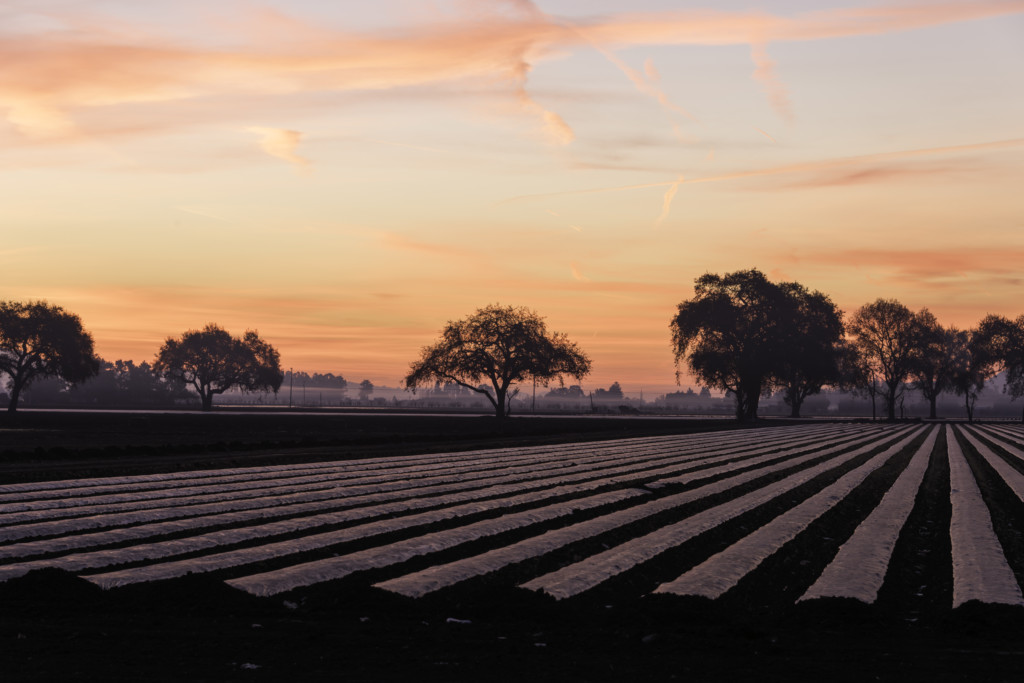Environment: Protecting Coyote Valley supports long-term viability of local farming
In the past four decades, 45 percent of prime farmland was converted into urban sprawl area
![]()

A farm field in Mid Coyote Valley at sunrise. Photo courtesy Open Space Authority
By Staff Report
The Santa Clara County Board of Supervisors voted Dec. 14 to solidify its commitment to protect Coyote Valley’s farmers, local food production, water, flood control, open space and natural resources by working with conservation groups, farmers and the city of San Jose.
 The protection of Coyote Valley, which buffers the rural South Valley from the urbanization of Silicon Valley, has been an ongoing process during the decades. More than 1,400 acres of natural and working farmlands are now protected for conservation across the Valley floor, creating a vital wildlife linkage that connects over one million acres of habitat in the Diablo Range and Santa Cruz Mountains.
The protection of Coyote Valley, which buffers the rural South Valley from the urbanization of Silicon Valley, has been an ongoing process during the decades. More than 1,400 acres of natural and working farmlands are now protected for conservation across the Valley floor, creating a vital wildlife linkage that connects over one million acres of habitat in the Diablo Range and Santa Cruz Mountains.
Last month, 60 acres of prime farmland at Laguna Avenue and Santa Teresa Boulevard in the middle of Coyote Valley — also known as Mid Coyote Valley — were added to Coyote Valley’s growing network of protected lands. The purchase was made by Santa Clara Valley Open Space Authority, a nonprofit working to establish sustainable, local climate-smart agricultural practices within the Coyote Valley Conservation Program Area.
 “This acquisition is a win-win for our community — preserving farmland and securing open space,” said Mike Wasserman, president of the Santa Clara County Board of Supervisors. “I applaud the work of the Santa Clara Valley Open Space Authority and their collaborative approach to protecting the natural and working lands of Coyote Valley.”
“This acquisition is a win-win for our community — preserving farmland and securing open space,” said Mike Wasserman, president of the Santa Clara County Board of Supervisors. “I applaud the work of the Santa Clara Valley Open Space Authority and their collaborative approach to protecting the natural and working lands of Coyote Valley.”
Working with public and private partners, the authority protects natural and working lands through conservation easements and purchases with willing sellers. The authority purchased the newly-acquired farmlands from WP Investments, LLC, in partnership with the State of California Department of Conservation through the Sustainable Agricultural Lands Conservation program, Santa Clara Valley Transportation Authority, and the Santa Clara County Planning Department.
 “The protection of Mid Coyote Valley farmland supports the long-term economic and environmental viability of local agriculture,” said Andrea Mackenzie, OSA general manager.
“The protection of Mid Coyote Valley farmland supports the long-term economic and environmental viability of local agriculture,” said Andrea Mackenzie, OSA general manager.
“Preserving this land in Coyote Valley contributes to ecological, economic, and quality of life benefits and serves as an appropriate natural infrastructure complement to our work to upgrade the region’s transportation infrastructure,” said Ann Calnan, environmental programs manager for VTA.
VTA provided 2016 Measure B funds through the US 101/SR 25 Interchange Project to help preserve these farmlands.
Purchasing and protecting working farms and ranches also demonstrates how the OSA is working with Santa Clara County to implement the comprehensive Santa Clara Valley Agricultural Plan and help combat climate change, Mackenzie said.
“The Agricultural Plan is a roadmap to protecting the multiple benefits that our region’s remaining farmlands and working lands provide,” she said.
The plan was developed with SALC funds totaling $200,000 from the state’s Strategic Growth Council and Department of Conservation to protect ag lands as a climate resilience tool.
In the past 40 years, 45 percent of Santa Clara County’s prime farmlands have converted to urban sprawl. To help slow this trend, the authority is working with local, regional, and state policymakers and programs to develop a growing body of research about the benefits and ecosystem services these natural and working lands provide.
These benefits include groundwater recharge, flood management, food production, climate mitigation, and biodiversity protection. Through the recent acquisition, the authority also aims to connect people to the importance of food security and the many environmental benefits local farmers and farmlands provide.
The OSA plans to manage and assess the property’s condition over the next year, collaborate with farm advisors and seek a tenant for agricultural operations that will further Coyote Valley conservation goals. The OSA expects to release a request for proposals in late 2022 for an agricultural tenant.
For more than 20 years, Luis Gaytan has leased farm land in Coyote Valley.
“This really will make a difference for me and future generations,” he said. “To preserve cropland will really help me, my family, and everyone. Why? Because it’s easy and simple. No land, no farmers, no food.”
Gaytan leases from Peninsula Open Space Trust120 acres of Coyote Valley farmland, where he grows alfalfa and oat hay. “My dream is to own 10 to 20 acres of land…and that way I can keep growing food and help others.”
- Results of March 5 primary election show nearly 23 percent SCC voters turn - March 9, 2024
- Mushroom Fest coming back Memorial Day weekend - February 9, 2024
- Garlic Festival seeking sponsorships - February 9, 2024
